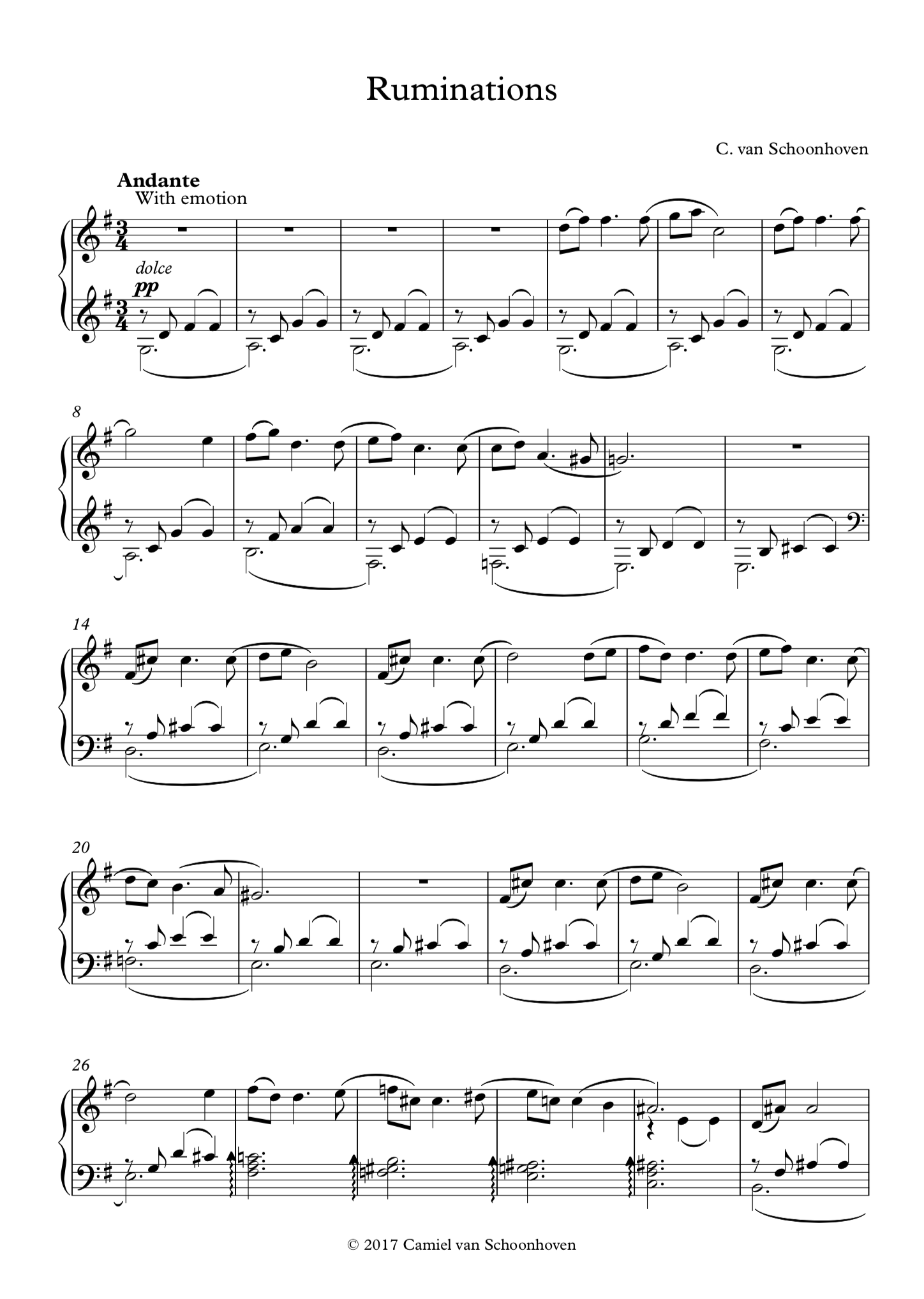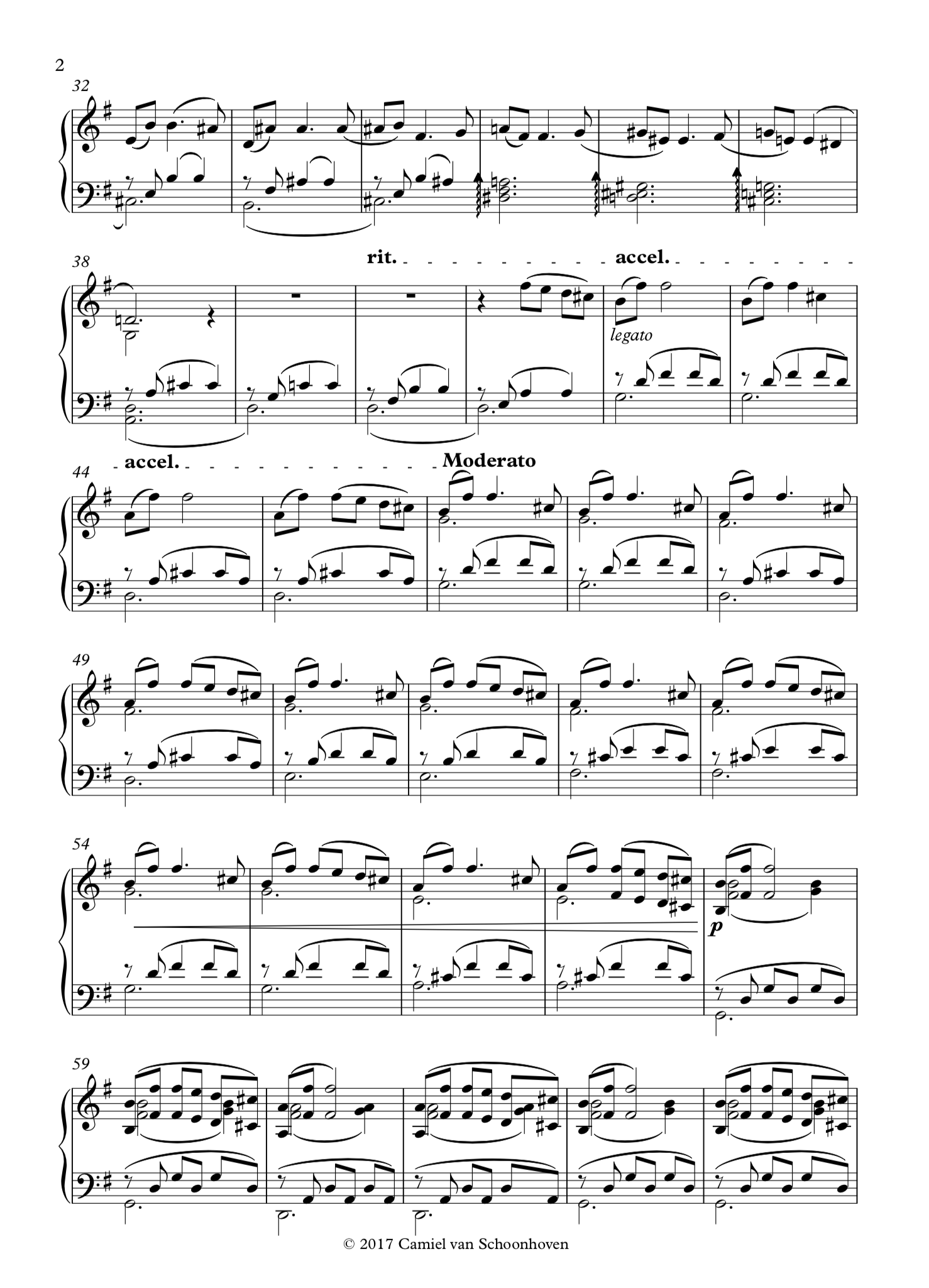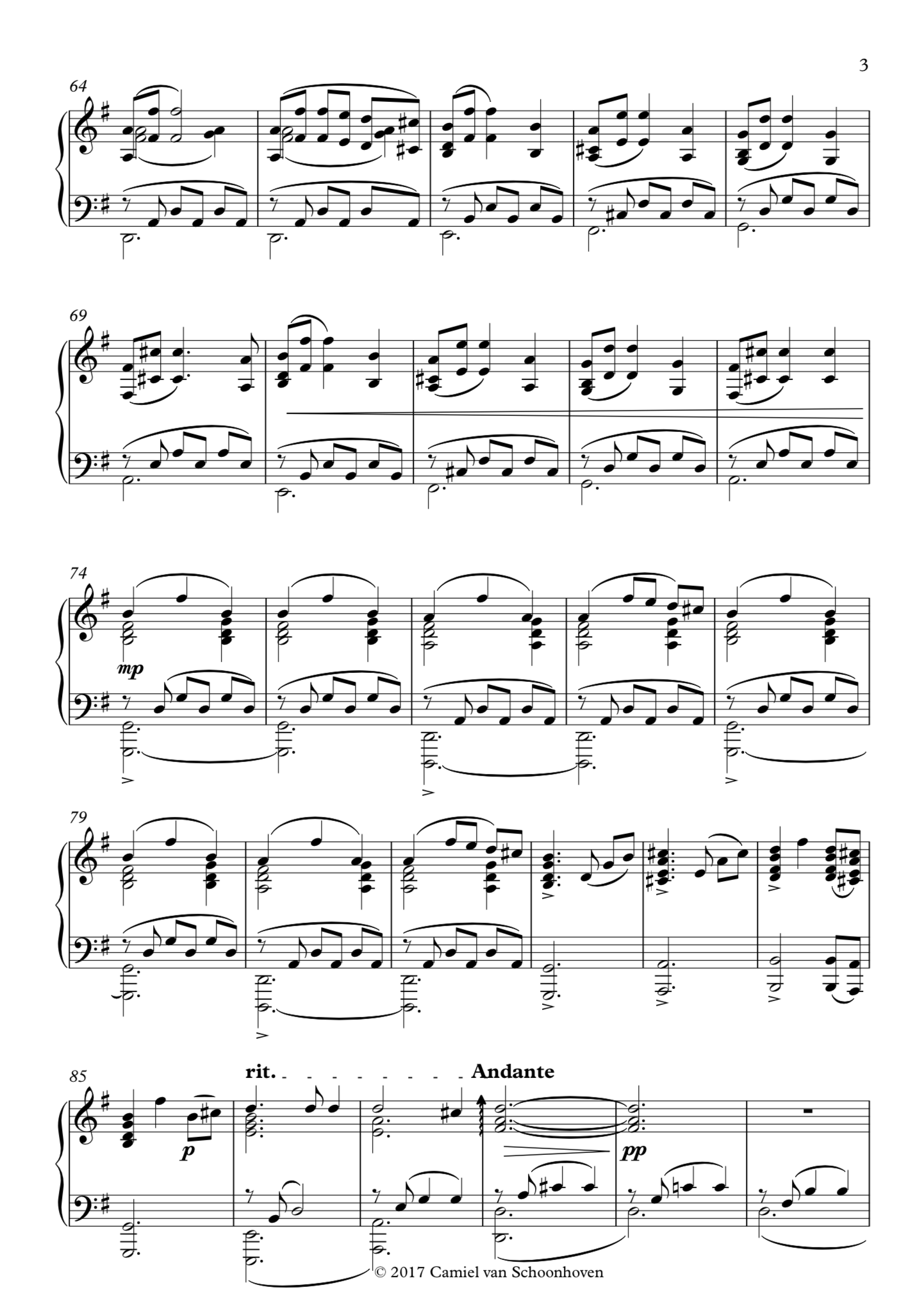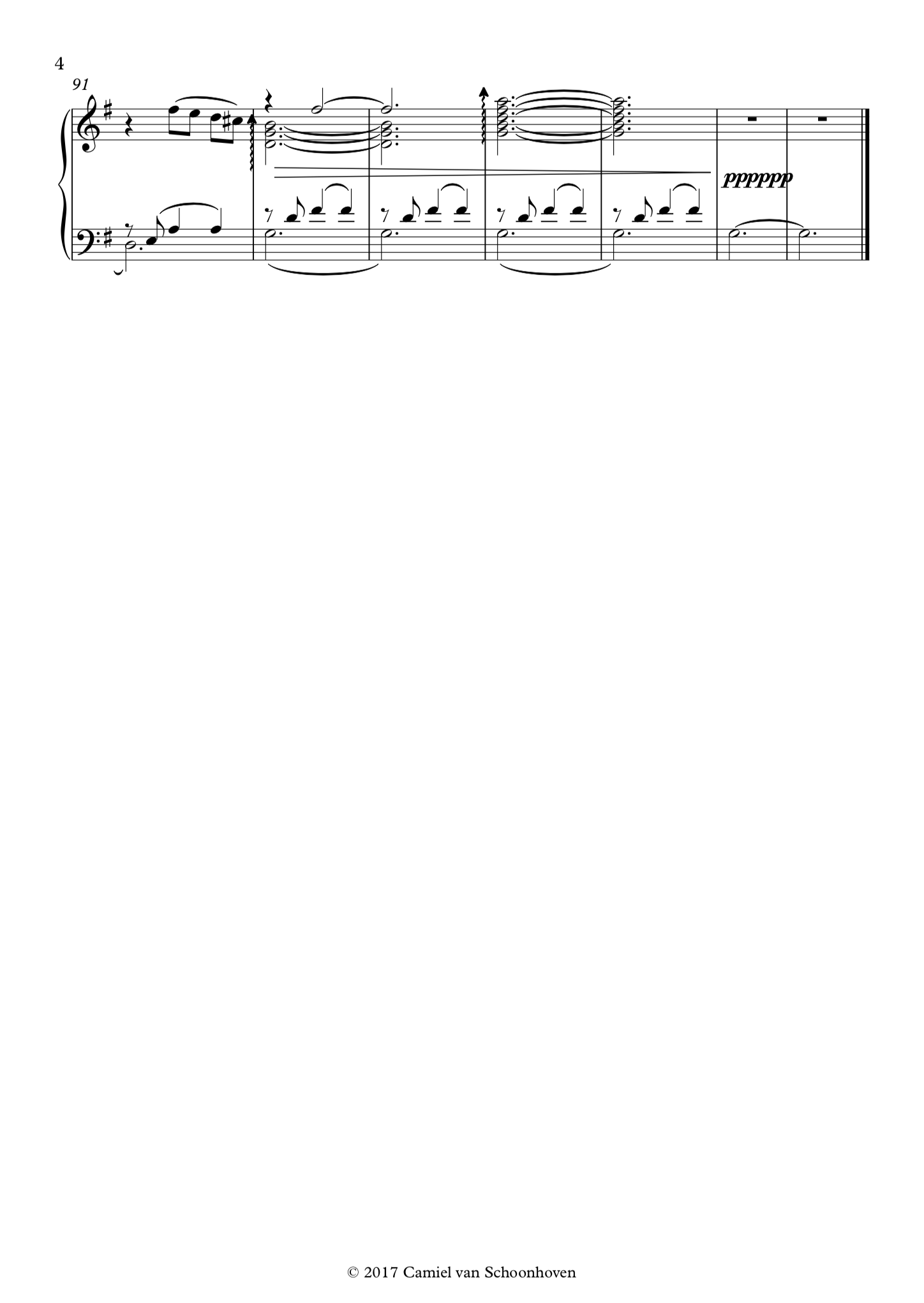Composing Spotlight: Ruminations
Hello!
I have written a wide variety of music and I felt like writing a series on my compositions and how they came to be.
So, first up is Ruminations.
I wrote Ruminations over the course of five days in October 2017 at the request of a friend who was in dire need of a piano piece for a university project that was soon due. The brief was simple: it had to be mysterious and melancholic, like a person with amnesia slowly remembering their past. The piece also had to be seamlessly loopable and for piano only. An interesting challenge for such a short timeframe.
First, I needed to set the tone and find inspiration. I was supplied with a few example pieces to help me understand the tone the designers were going for: the entire Dear Esther soundtrack and Hundred Waters - Blanket Me. In addition to this, I explored the Last Last of Us soundtrack as well as the iconic Minecraft soundtrack.
Knowing what I wanted to create I set about coming up with ideas. The first thing on my mind was to make it easily loopable and do this I opted for a simple and recurring rhythm that I can return to in the bass while crafting an ominous melody to overlay on top. This presents itself immediately when the piece starts and continues largely unabated throughout the music.
Opening four bars, which sets the rhythm and tone for the first half of the piece.
The key signature and time signature were difficult choices. I didn’t want to pick a minor key for fear of draining the mood entirely from the piece, but nor did I want it to be overtly happy. After all, it is a piece about mystery and confusion. I ended up settling on G-Major, but put a twist on things by rapidly shifting into the lydian mode, meaning it had two sharps (F# and C#) rather than the usual one (F#). The time signature was no easier; I definitely did not want the standard 4/4 common time. My first preference was for something more unsettling like 11/8, but ultimately to assist in the loopability of the piece I went for 3/4 while trying in other ways to mess with the beat. As such, I took care not to stress the first beat of each bar, instead choosing to put more emphasis on the second beat.
The next step was to decide the melody and harmony. The brief made it such that the harmonies were more important than the melody. So, to reduce emphasis on the melody I created something simple without any fancy bells of whistles. Creating the melancholic feel of the piece was all in the interaction between the rhythm and the harmony. This meant no explicit chords and no natural chords. Everything had to be broken down into the chime of the bass and every chord had to be ominous in some way. Namely, this meant the chords were generally either augmented, with a seventh or totally outside the key signature. This is profoundly obvious as soon as the piece starts, with the first eight bars of the melody going through the following chord sequence:
Gmaj7 | Am7 | Gmaj7 | Am7 | Bm7 | Caug4 | Fmaj7 | Emin7
This then leads the melody into the lydian mode and augments itself into:
Dmaj7 | Em7 | Dmaj7 | Em7 | Gmaj7 | Caug4 | Fmaj7 | E7
Main melody of the first half of the piece, in G-lydian (or D-major).
Later in the piece we get a series of descending chromatic diminished chords that slowly bring the piece back to it’s Gmaj7 home chord to finish and loop back to the start for a total length of 1m 30s.
After applying some ambience and convolution the result was a very ominous and melancholic piece of music that really gives you this feeling that something’s not right but yet it still is. The developers were pleased, but not pleased enough. They requested a second piece of music for when you finally do overcome your amnesia. or in their words, an '“intensification”. Perfect! That’s my specialty.
Originally I intended to write a seperate short piece that could pick up where the first left off, but ultimately I ended up put in a dramatic ritardando to mash the two into one piece with two halves. This was not easy task. The music I had written did not owe itself to the kind of intensification that was sought. So, instead I had to come up with something new that still felt familiar. This is where the melody comes in. I decided to tie it back to a common theme in the melody by choosing the first two notes of the melody - those two very first notes you hear on the upper end of the piano - and went to town with them. With those two notes and a transitional note, plus exploitation of the Gmaj7 chord and its close friend the Dmaj7 chord, I crafted a gradual intensification which is different, yet strikingly familiar.
Transition between the two halves of the piece. Notice the similarities to the melody, but in modified form and in the home key of G-major.
Slowly and subtly I changed the underlying rhythm to shift the emphasis from the second beat to the first and third. The tempo increased, the dynamics increased and finally the melody was playing more than one note at a time. No more was it to be a simple melancholic jingle, but it was to become requiem of memories as you rise out of the confusion of the storm and into the brightness of day. Finally, when you emerge from your ruminations and, for the first time, your mind is clear, the piece swells into greatness and joy.
At this point I dropped almost every reference to the original themes, after all it was meant to signify a reawakening. The ‘7’s were dropped from the chords, simply becoming G and D. The rhythm had been broken down into something more forceful and driving. The harmony found itself with full chords being pounded out under the melody. The melody itself taking those first two notes and pushing it into something so simplistic you absolutely relatable to the melancholy that came before it.
The grand climax of the piece, with significant developments from the initial themes.
Then, the final trick: bring it all back to the Gmaj7 chord and make it loop. Once all the dust had settled this was as simple as deintensifying, gradually slowing down the tempo and reintroducing the main rhythm underneath the melody. Then, to end, a gentle mash of the two themes and a full circle back to the start for 3m 25s.
That is thought process behind the piano piece Ruminations which I wrote in its entirety over the course of five days.
Did the developers like it? They loved it, and into their project it went.
Thanks for reading and I hope you enjoyed this spotlight!








